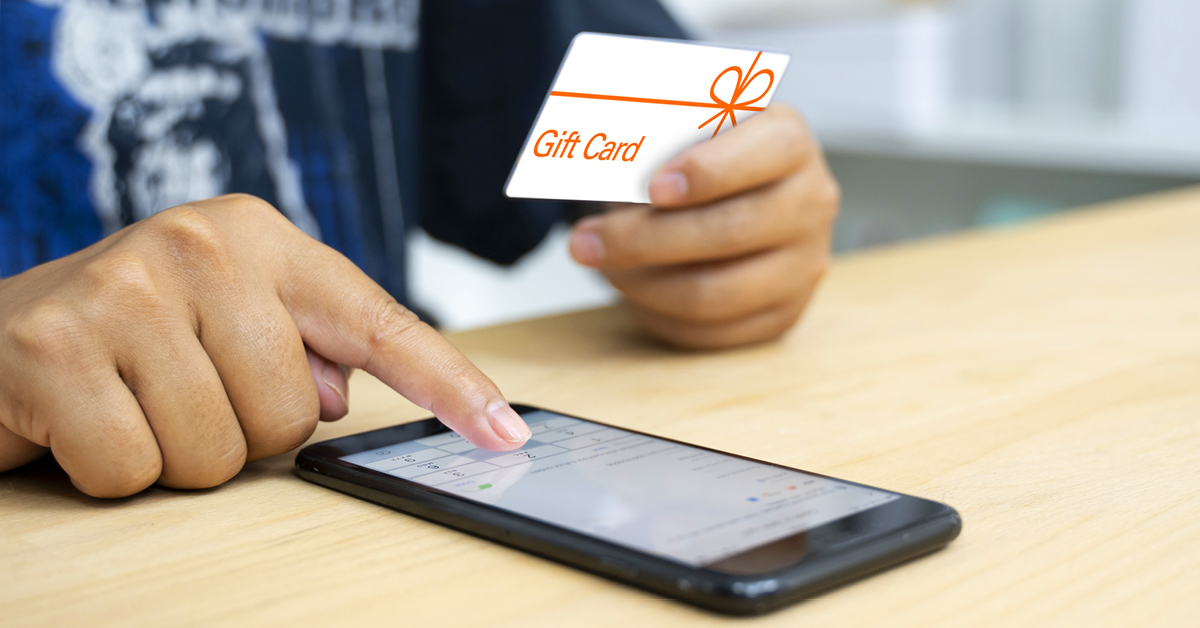
With Americans spending more time on their mobile phones than on desktop computers, it’s never been a better time to incorporate a digital gift card strategy into your business’ holiday plans.
Since the mobile phone has become an integral part of the shopping experience, it only makes sense that customers would demand that gift cards go digital and mobile, making their acquisition, distribution, and redemption as quick and convenient as paying with their tried-and-true debit and credit cards.
For the consumer, the benefits are simple to see: digital gift cards are easier to buy, easier to give, easier to keep track of, and are an easier forum in which to earn loyalty rewards.
For retailers and restaurants, the primary benefits are the additional new channels through which they can sell gift cards, reaching a younger demographic than they may have with traditional plastic cards.
Mobile gift cards also offer an additional benefit to the retailer by enabling them to reach out and touch customers like never before—driving brand messaging, offering rewards, and bringing foot traffic back to brick-and-mortar locations via push notification marketing.
Still not convinced though?
Below, we’ve outlined the five best reasons we believe that incorporating a mobile gift card strategy at your business will be a big win for you this holiday season:
1. Reach the Procrastinating Holiday Shopper
Today’s customers, most notably millennials, expect a dialogue with the businesses they support. Virtual gift cards are a perfect tool to enhance the consumer experience by creating an engaging medium for customer contact, incentivizing behavior, or rewarding frequency of purchases.
This contact shouldn’t be limited to rewarding “brick and mortar” activity either. As consumers frequently use multiple channels in-store to purchase goods and services (commonly called “webrooming”) innovative retailers need to engage with consumers online and in brick-and-mortar locations to drive engagement.
The smallest incentive, even $5, can turn a lost sale into a satisfied customer that believes the brand they frequent recognizes their patronage.
For example, if a consumer doesn’t complete a purchase they started online, leaving their purchase in a virtual basket, a retailer could send an instant gift card to entice that consumer to complete the purchase, either online or in-store. The smallest incentive, even $5, can turn a lost sale into a satisfied customer that believes the brand they frequent recognizes their patronage. And we know from our Consumer Insights Study that, on average, consumers spend $23 over and above the original gift card, so businesses that employ this tactic see return on their investment many times over.
2. Incentivize Your Rewards Junkie to Buy More
With today’s consumers able to access nearly everything instantly from their fingertips, from shopping, to finding a great restaurant, or booking a hotel, it’s imperative that brands meet their needs quickly and efficiently. This concept is especially relevant when thinking about consumer loyalty programs.
Gone are the days of sending a promotion in the mail or providing a mail-in rebate or reward that requires the consumer to get out a stamp and envelope in order to redeem a reward—nobody has time for that anymore.
Today consumers want ease of use and instant rewards, and if brands are to stay relevant, they need to provide mobile-savvy consumers of every demographic ways to engage and earn rewards where they are—most often on their mobile device. As the First Data 2014 Consumer Insights Study showed, 40% of all gift card recipients end up spending more than they originally planned because of an incentive being offered at the time of redemption.
3. Incentivize your Instant Gratification Customer to Promote a New Behavior
As gift cards become a key component in driving loyalty and building brand awareness, retailers need to ensure they communicate the value of their gift card programs using in-store signage in as many places as possible. This is critical for program participation as new mobile options like apps and mobile-ready websites are added.
Drive engagement with the “instant gratification” customer by incentivizing them with a gift card when they download the new app to their mobile phones.
It’s great to have unique features and functionality to drive an omni-channel experience for consumers, but those features will go unused if the retailer fails to make those consumers aware the tools exist. We know from our mystery shopping research there are a variety of factors that make signage memorable including color, size, and placement. Gift card signage needs to be clear, concise, and large to be impactful.
Have a new app? Drive engagement with the “instant gratification” customer by incentivizing them with a gift card when they download the app to their mobile phones.
4. Recognize Your Social Media Promoter
A recent article by Fact Tank noted that 57% of all American adults use Facebook. Sixty-four percent use the site on a daily basis, up from 51% in 2010. All social media users are acutely aware of the brand messages shared by brands as well as friends and family, and whether we “like” them or not, our exposure to brands occurs each time we engage with social media via the vocal brand evangelists we each have within our individual social circles.
Savvy brands are leveraging those brand evangelists to spread brand messaging and engagement using gift cards. Rewarding customers that promote your brand is one way to “spread the love,” creating positive sentiment towards your brand that these evangelists are almost guaranteed to share with their circles.
Spot positive brand messaging from a client on Instagram? Reward them with a quick gift card. It is the fastest way to ensure they repeat the behavior and promote your brand over the holiday season.
Available technologies enable tech-savvy customers to purchase gift cards from the retailer directly through Facebook widgets, ensuring a seamless and instant experience. Moreover, brands should utilize the power of mobile technology to provide instant virtual incentives, rewards, and even acts of contrition when they fail to meet customer expectations.
5. Deliver Cards in a Format Your Customers Demand
Last but not least, the key to any successful virtual program is participation in a mobile app or wallet. According to the First Data Consumer Insights Study, 55% of consumers said they are interested in using a mobile app to store their gift card information. This demand for app-based gift card programs is an opportunity for retailers to gain key analytics about consumers by promoting the registration of gift cards in mobile apps.
In the mobile app format, gift cards are no longer anonymous but become rich, powerful marketing tools with the ability to capture customer identities, preferences, purchase behavior and information, and even offer the ability to manage a loyalty program via the mobile app-based gift card platform.
Fifty-five percent of those surveyed said they are interested in using a single gift card app to store all their gift card information, including those from multiple stores or restaurants.
While some industry thought leaders believe retailers should offer mobile gifting solutions through their own websites and mobile apps, offering e-gift cards via third-party digital channels, including gift card-specific mobile apps, provides more opportunities for consumer growth; 55% of those surveyed said they are interested in using a single gift card app to store all their gift card information, including those from multiple stores or restaurants.
________________________________
Make 2015 your most profitable holiday season ever by incorporating a mobile gift card strategy. For more information about maximizing gift card revenue, contact a First Data Virtual Prepaid Solutions representative today.





